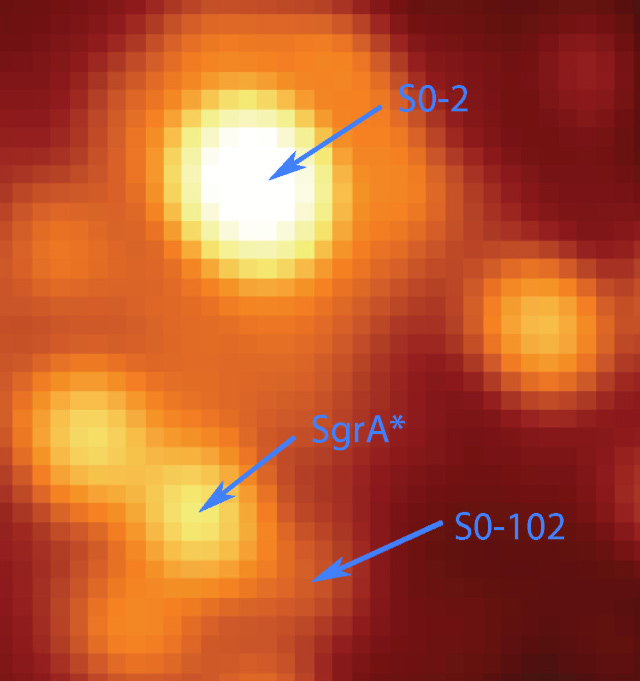BLACK HOLE ENVIRONMENT
Nuclear Star Clusters in the vicinity of Black holeAdaptive optics spectroscopy has allowed for spectral identifications of bright stars within ~1 pc of the supermassive black hole and has revealed two very unexpected results. The first surprise was the detection of a wealth of young (<10 Myr) stars in a region where none were expected due to the strong tidal field of the black hole and the low present-day gas densities. The second surprise was the unanticipated dearth of late-type stars near the black hole. A young (4-8 Myr) nuclear cluster surrounds the Galactic Center black hole and extends out to a radius of 0.5 pc. What is their formation history? This is an essential question in the study of the co-evolution and growth of Super Massive Black Hole and the nuclear star clusters that surround them. The origin of young stars, where and when the clusters formed, is difficult to explain since the gas densities observed today are orders of magnitude too low for a gas clump to overcome the extreme tidal forces and collapse to form stars. The star clusters' proximity should cause them to be torn apart, and thus their presence within the strong tidal field of our Galaxy's central SMBH still remains a puzzle. If the star clusters formed in situ, then the events leading up to its formation were likely unique and extreme compared to those found in the local solar neighborhood. s The Arches and Quintuplet clusters are some of the most massive, young clusters in the Milky Way. They are located ~30 pc in projection from the black hole, and formed in one of the most extreme environments in the Galaxy. Again, these clusters experience strong tidal shear forces from the supermassive black hole. Along with the young star clusters in the immediate vicinity of the Galactic Center, these clusters provide an ideal opportunity to study how stars and clusters form under extreme initial conditions. |

|
Dearth of Old StarsDynamically relaxed star clusters with a massive black hole are predicted to have a steep increase in stellar density toward the black hole. The red giant stars in the nuclear cluster are likely old enough (1-10 Gigayears) to have formed such a cusp. However, star counts using AO spectroscopy and medium-band imaging have shown that the red giants have a very flat projected surface dnsity profile close to Sgr A*, the central black hole, strongly suggesting that the observed number is far below the predicted. Converting the projected profile to a 3D profile is difficult but it is essential for understanding how the nuclear cluster's formation and evolution differ from current theories. The density profile is also a key input for models of black hole growth. Thus |

Image courtesy .. |
G2: A Gas Cloud or a Star?For years, astronomers have been puzzled by G2, a bizarre object in the center of the Milky Way that was believed to be a hydrogen gas cloud headed toward the black hole in the Galactic Center. The Galactic Center Group members closely monitored G2 during its closest approach to the black hole during summer of 2014 and found that the black hole survived. If G2 were a gas cloud, it would have been torn apart as it approached the black hole. Instead, our team demonstrated that G2 is a pair of binary stars that had been orbiting the black hole in tandem and merged together into an extremely large star, cloaked in gas and dust. |

Image courtesy .. |
Discovery of the shortest period star, S0-102Stars with short orbital periods at the center of our galaxy offer a powerful probe of a supermassive black hole. Over the past 17 years, we have used the W. M. Keck Observatory to image the galactic center at the highest angular resolution possible today. By adding to this data set and advancing methodologies, we have detected S0-102, a star orbiting our galaxy's supermassive black hole with a period of just 11.5 years. S0-102 doubles the number of known stars with full phase coverage and periods of less than 20 years. It thereby provides the opportunity, with future measurements, to resolve degeneracies in the parameters describing the central gravitational potential and to test Einstein's theory of general relativity in an unexplored regime. L Meyer et al. (2012). |

Image courtesy .. |
Properties of the Remnant Clockwise Disk of Young Stars in the Galactic CenterUsing high precision kinematic measurements and modeling of 116 young stars in the central 1 pc of the Galaxy, we derive the ensemble properties of the clockwise stellar disk. The disk is made up of ~20% of the young stars, which revolve around the supermassive black hole on non-circular orbits. The estimated eccentricities can be achieved through dynamical relaxation in an initially circular disk with a moderately top-heavy mass function, which has been recently found. Lu et al. (2013). We also find that the B stars have similar kinematic properties as the more massive O and WR stars, suggesting a common star formation event. For more details, see the Yelda et. al (2014). |

Images shows an increase in density of stars (red/blue region) |